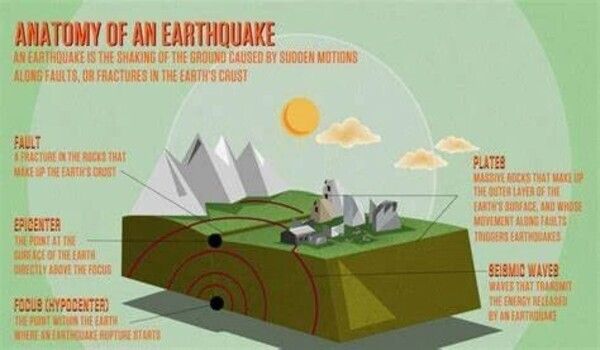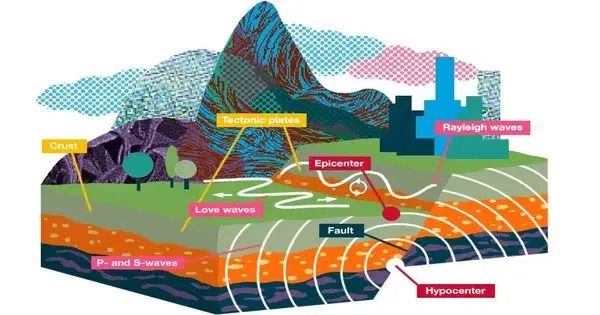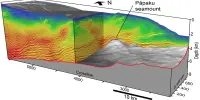Human-caused earthquakes, known as induced seismicity, have become a growing issue. These events may occur during fluid injection or extraction in oil or gas reservoirs, wastewater disposal, or geothermal reservoirs. On a few occasions, larger so-called ‘runaway produced earthquakes’ were strong enough to provoke public worry and project cancellation (e.g., 2006 Basel/Switzerland) or even significant damage (2017 Pohang/South Korea).
Intense study, however, has resulted in successful initiatives to prevent such runaway events, such as the Helsinki geothermal project in 2018. The key to consistently avoiding large-scale generated earthquakes is to better understand the underlying physics processes.
In a new study published in the Proceedings of the National Academy of Sciences, Dr. Lei Wang and his colleagues from the GFZ Section ‘Geomechanics and Scientific Drilling’, together with researchers from the University of Oslo, Norway, report that the roughness of pre-existing faults and associated stress heterogeneity in geological reservoirs play a key role for causing such runaway events. The study combines novel fluid injection experiments under acoustic monitoring performed in GFZ’s geomechanical laboratory with numerical modelling results.
”We found that rough and smooth faults in the rocks behaved entirely different during our laboratory experiments. This is an exciting observation as we evidenced the progressive localization of microseismic activity indicating stress transfer before large induced events during fluid injection”, says the first author Dr. Wang who designed and performed the experiments and the modelling.
‘We found that rough and smooth faults in the rocks behaved entirely different during our laboratory experiments. This is an exciting observation as we evidenced the progressive localization of microseismic activity indicating stress transfer before large induced events during fluid injection.
Dr. Wang
Injection-induced seismicity in the lab highlights the important role of fault roughness
Roughness for active faults and fractures along tectonic faults, as well as pre-existing but dormant faults in geological reservoirs, is difficult to quantify. To circumvent the lack of resolution while imaging or monitoring such defects in nature, the study team ‘down-sized’ to the decimeter-scale, creating laboratory faults with determined surface roughness. These were then pushed to near-critical stress levels utilizing a triaxial MTS compression device. The rock samples were also outfitted with a variety of sensors, including piezo-based lab seismometers, to detect hundreds of micro earthquakes, known as Acoustic Emissions, which indicate deformation within the pressured rocks before they shatter.
Fluid injection was then performed into the samples simulating fluid injection in geological reservoirs. ”Controlling the boundary conditions and using a dense monitoring network in the lab enabled us to image the evolution of induced laboratory earthquakes as well as slow aseismic deformation and derive key-parameters such as fault slip and slip rate, providing a comprehensive image to better understand the physics of injection-induced seismicity”, says Georg Dresen, professor in GFZ’s Section Geomechanics and Scientific Drilling, who supervised and initiated the study.
Compared to smooth faults, injection-induced slip on rough faults produces spatially localized clusters of Acoustic Emissions occurring around highly stressed asperities. It is there that induced local slip rates are higher, accompanied by a relatively higher number of large events. This mechanism is typically measured in the ‘Gutenberg-Richter b-value’ as a measure for stress.
Fluid injection first reactivates the fault patches through slow, aseismic slip and causing only few and small seismic events, followed by a progressive localization ultimately leading to large induced events. ”This study has important implications for induced earthquakes: It means that when monitoring fluid injections in geological reservoirs in real-time, this may allow identifying such localization processes before the nucleation of larger induced events allowing to avoid them”, says Prof. Marco Bohnhoff, head of GFZ’s section Geomechanics and Scientific Drilling.

The similarities between laboratory-scale and field-scale induced seismicity
To further investigate the relevance of lab experiments for earthquakes in geological reservoirs, the authors compiled a wide range of datasets of induced seismicity, studying the emitted energy as a function of hydraulic energy from laboratory-scale and in-situ fluid injection experiments, reservoir-scale hydraulic fracturing, and geothermal and waste-water disposal projects around the world. The value of seismic injection efficiency (i.e., the ratio of energy emitted in earthquakes to hydraulic energy injected into the system) distinguishes between pressure-controlled and uncontrolled ruptures.
In contrast to runaway events with high seismic injection efficiencies, induced seismicity showing an extended pressure-controlled rupture typically shows a much lower seismic injection efficiency. Dr. Wang emphasizes that ”our laboratory observations bear similarities with those field-scale induced earthquakes corresponding to pressure-controlled ruptures, as reflected by the fact that in our experiments the induced fault slip terminates shortly after we stop fluid injection”.
The goal is to ultimately control and avoid large induced earthquakes
The work is part of a newly launched research project aimed at better forecasting produced earthquakes in geological reservoirs and, ultimately, huge catastrophic natural earthquakes. Part of this attempt is to transfer field-scale processes to the laboratory, where boundary parameters may be controlled and seismic occurrences can be duplicated.
Marco Bohnhoff concludes: “Only modern data processing methodologies and adjusting classical seismological methods to investigate earthquakes, now also in the lab, lay the foundation for understanding the rock deformation processes in more detail. Studies like the one published by Wang and his co-authors have the ability to reduce man-made seismic dangers, which is a prerequisite for public approval when employing the geological underground for energy storage and extraction as a crucial component of the energy transition.”
















